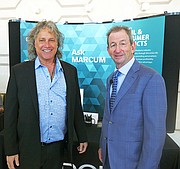RETAIL
American Rag Talks About Its New Path at Marcum Symposium
American Rag Cie is going to the Persian Gulf and possibly points beyond.
Mark Werts, cofounder and chief executive officer of the retail chain, which has been an important part of the Los Angeles scene since the 1980s, is planning in September to open a 9,300-square-foot emporium in The Dubai Mall in the United Arab Emirates with other locations in the Persian Gulf to follow in places including Abu Dhabi, Kuwait and Saudi Arabia.
Also on his retail roadmap are proposals to open stores in India and China. Meanwhile, he is reorganizing his Japanese operations, which means closing his last five stores, where once there were 17. That leaves room to open a Tokyo emporium sometime in 2019 while American Rag’s Japanese e-commerce operations will continue.
The overseas growth is taking place while American Rag’s domestic stores are scaling back. The company’s 12,500-square-foot store in the Fashion Island mall in Newport Beach, Calif., closed in January after a 12-year run, and Werts has quietly shuttered his company’s Industrie Denim division with locations in San Francisco and Scottsdale, Ariz.
Werts was one of several speakers at the second annual Marcum Retail Symposium, held April 19 at the JW Marriott hotel in downtown Los Angeles.
Accounting and advisory firm Marcum LLP produced the symposium to chart how fashion and retail are navigating tough markets. Speakers discussed subjects encompassing retail, fashion, technology, logistics, retail real estate and factoring.
During the symposium, Werts explained why American Rag was expanding overseas. “Would you rather open up in a market that has 9 percent to 10 percent growth or one that has extreme competition and an economy that the government says is growing 2 percent to 3 percent?” he asked.
Opening stores in air-conditioned malls in places such as the Persian Gulf makes sense for people who want to take a break from the region’s heat. In the United States, there is still a lot of growth for e-commerce, Werts said.
Ron Friedman, head of Marcum’s retail and consumer-products industry group, moderated the retail panel, which included Werts. He asked panelists Josh Goldman, senior vice president of Brookfield Properties, retail, and Brendan Kotler, development director for Westfield, about the direction of retail centers.
Goldman said there’s still a lot of business in retail centers. “Anybody who says retail is dead doesn’t know the real story. Retail is transitioning,” he said. “But it is transitioning from being transactional to being experiential.”
He believes that consumers will continue to need places to gather and be social. Malls will offer those places, and developers who thrive will be the ones creative enough to change shopping centers into places that offer unique experiences.
Goldman also mentioned Brookfield’s project to redevelop the California Market Center, a showroom building that is an important anchor in downtown LA’s Fashion District.
“Here is a historic fashion mart based on the transaction. There is a great opportunity to take advantage of the underlying real estate and transition it to a grand experience. It’s an experience that will speak to people in downtown LA. It will speak to the history of the project and be a place where people want to gather,” Goldman said.
The partially Brookfield-owned project features 2 million square feet of classic office space with 200,000 square feet of ground-floor retail and restaurants.
Kotler discussed Westfield’s $1 billion remodel of Westfield Century City. He agreed that retailers need to develop experiences and new ways to deliver retail excitement. One way to do that at Westfield Century City was with a permanent space used to host new pop-up shops every six weeks. The Hermès fashion house produced a laundromat-style pop-up in November.
Ilse Metchek, president of the California Fashion Association, led a panel on technology, logistics and factoring. Panelist Marc Heller, president of CIT Commercial Services, said that a lot of business opportunity remains for bricks-and-mortar stores. They might serve as distribution centers for retailers. He also believes the retail industry needs to find a way to bring back fashion, enticing consumers to buy more clothing.
Panelist Andrew Rotondi, chief operations/information officer of Dynamic Worldwide Logistics USA Inc.,
said that inventory management is becoming more crucial than ever. He forecast a market where an increasing number of retailers will look to technologies, including RFID, to manage their inventory. “Stores are going to get smaller, inventories will get more accurate and vendor management of inventories will be critical to the success of bricks-and-mortar,” he said.
Panelist Javier Carreras, an executive director at JP Morgan Chase Bank, talked about rising interest rates affecting retail. “Since 2015, the Fed has raised rates six times. We expect to see two more rate increases for 2018. If there’s a greater push to have more inventory levels, it means companies have to borrow, which will put additional strain on manufacturers and a lot of distributors,” Carreras said.
To start the symposium, Beth Goldstein, The NPD Group’s executive director and industry analyst for accessories and footwear, discussed the changing market for fashion retail. She said consumers were seeking comfort, convenience and curation from retailers and fashion.
Leslie Ghize, an executive vice president of the lifestyle think tank TOBE, also talked about consumers’ changing tastes and what they want from retailers. They’re interested in more-unique products, which will benefit retailers confident in trusting their gut to make merchandising decisions.
























